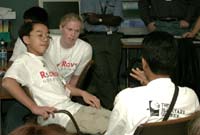|
 |
|
Jacqui Hayes, a 17-year-old Australian, center, will start at the
University of Sydney in March, taking advanced science.
Always interested in science, one of her school projects as a
child was to wire her doll house with electricity. She says,
"I'd love to be part of the upcoming Australian space
industry." She's also interested in biotechnology and
genetics. This was her first trip to the United States, so she and
her parents have enjoyed visiting tourist venues. Also shown
is Kevin Hou, United States.
|
|
Students also commented that they had learned how helpless they
could feel when they couldn't get an image they wanted and couldn't do
anything about it, and when the answer they got was not what they
thought it would be.
"Sometimes a negative answer is the answer,"
Anderson told them. "Part of learning is that technology
doesn't always work."
Shaleen Harlalka, an Indian student, said "We're really lucky
for this entire experience."
The students and their countries are: Paul Nicholas Bonato, 17,
Australia; Avinash Chandrashekar, 12, India; Kimberly DeRose, 15,
United States; Shaleen Harlalka, 17, India; Jacqueline Cherie Hayes, 17,
Australia; Daniel Jan Hermanowicz, 11, Poland; Kevin Hou, 13,
United States; and Bhushan Prakash Mahadik, 15, India.
They were accompanied by Glenn Cunningham, retired JPL Mars
Global Surveyor project manager, Dr. Bruce Betts and Emily Lakdawalla
from the Planetary Society and teacher Charlie Lindgren (CK).
The Planetary Society, Pasadena, Calif., created the Red Rover Goes
to Mars project to give exceptional students worldwide a unique opportunity
to participate in performing real science using robotic rovers. Student
navigators were selected from well over ten thousand international contest
entrants, all of whom wrote journals chronicling their experiences
teleoperating LEGO rovers. The general public was also invited to
participate in the program through the
Red Rover Goes to Mars
International Art Competition, at http://planetary.org/rrgtm/artcontest.html ,
and the
Send Your Name to Mars
campaign, at http://spacekids.hq.nasa.gov/2003 .
Red Rover Goes to Mars grew out of the successful Red Rover, Red
Rover project. Red Rover, Red Rover allows classes of students to build their
own Mars rovers from LEGO bricks and guide them through simulated Mars
environments that they build. Students can also operate rovers built by
other classes over an Internet connection.
For more information about the
Red Rover Goes to Mars program,
please see http://planetary.org/rrgtm/index.html . For more information
about
NASA's Mars program, please
see http://marsprogram.jpl.nasa.gov . The
JPL home page is at http://www.jpl.nasa.gov .
|